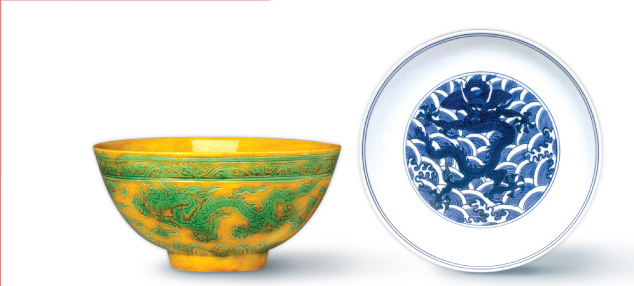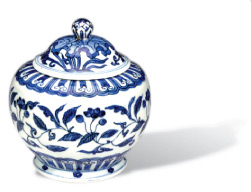 |
|
|

|
Yellow-glazed bowl with green dragon and phoenix design. Jiajing Period. Diameter 14 cm, Height 7 cm
|
|
Underglaze blue dish with dragon design. Wanli Period. Width 20 cm, Height 4 cm
|
|
|
| |
|
For many, the Ming Dynasty is synonymous with exquisite porcelain. For centuries the distinctive blue and white ceramics have been prized and endlessly copied.
In the 16th century, Portuguese kings were so enamoured of the finely executed treasures that they lined a ceiling in Lisbon's Santos Palace with the distinctive plates and bowls.
Quality control in the production of Ming imperial porcelain was so rigorous that these blue and whites are considered indisputably superior to those of any other period.
Indeed, the trade in blue and white porcelain helped turn China into an economic powerhouse. It has been estimated that half the silver produced in the Americas during the Ming Dynasty found its way to China to pay for porcelain, silk and tea.
However, until recently, the material ware of the late Ming period has been largely overlooked in the belief that, due to an ailing economy, its quality does not meet the peerless standards set in earlier periods.
The University's Museum and Art Gallery is hoping to turn that belief on its head with the world's first exhibition devoted exclusively to the imperial ware of the late Ming Dynasty.
This collection of 120 stunning pieces created for two separate imperial households – during the reign of Jiajing (1522-1566) and Wanli (1573-1620) – has been a year in the preparation.
The exhibits, mostly produced in the Jingdezhen Kiln, Jiangxi province between 1520 and 1620, come from the Museum's own small collection, plus over 100 pieces loaned from nine private collectors in Hong Kong. |
Museum Director, Mr Yeung Chun-tong says, "Some collectors may think the quality is not as good as those in the early Qing and early Ming Dynasties, but they were made for the Emperor so the quality at that time should have been the best. We have launched this exhibition to try and study their styles and increase their status."
The largest group on display is the famous blue and white porcelain, but a smaller group of stunning wucai (five colours) ware can also be seen.
The decorative style is particularly distinctive. "All imperial ware contains dragon and phoenix motifs," explains Mr Yeung. "But even judging from this you can still see differences. The dragons during this period have very big, bulging eyes, it's a very special feature of the late Ming, and the dragon's head may be over-exaggerated. They liked to paint the dragon in this unrealistic way, because during that period the painter was trying to stress the power of the dragon head.
|

| |
Underglaze blue covered jar with floral design. Wanli Period.
Width 13 cm, Height 14 cm |
|
|
|
"Before Ming – during the Yuan Dynasty –
the dragons in ceramics had smaller heads
and stronger bodies, completely different
proportions that signifi ed the power of the
Mongols who had expanded their power
into Central Asia and Eastern Europe. Here
the power is in the body not in the head. By
the late Ming all the power is in the head."
Because of Jiajing's fascination with religious Daoism as a means to longevity many of the pieces are decorated with symbolic Daoist motifs, such as the auspicious shou character, cranes and the eight immortals.
'The Fame of Flame: Imperial Wares of the Jiajing and Wanli Period' exhibition runs at the University Museum and Art Gallery until February 28, 2010.  |
|
|
|
|

